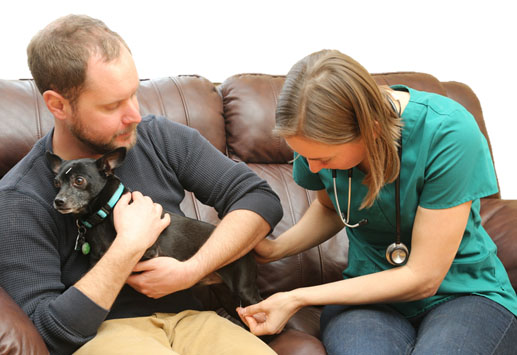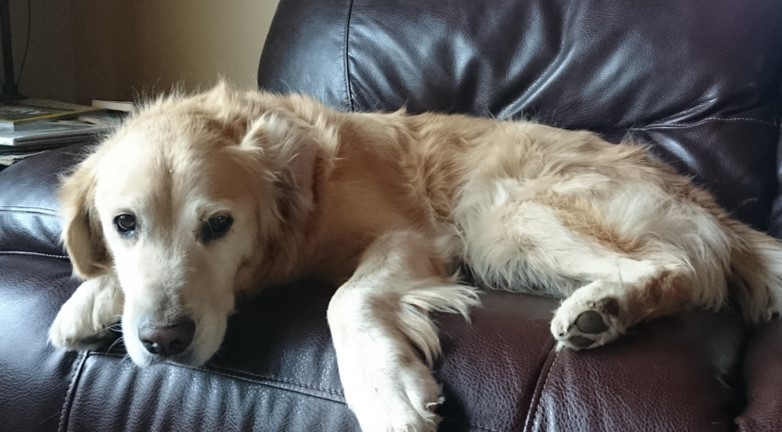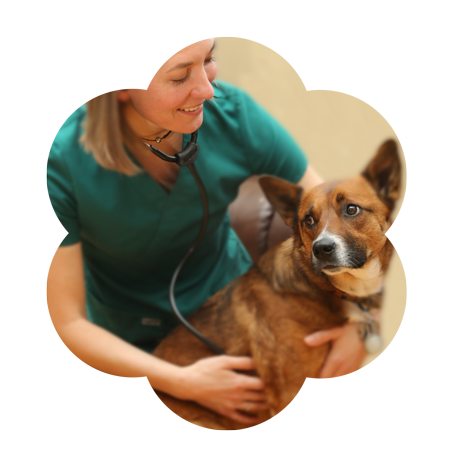Acupuncture involves inserting thin needles into specific points on the body in order to achieve a specific change in the body. It is part of a system of medicine developed in ancient Asia, and modern research supports its efficacy for a wide range of conditions. The style of acupuncture that Dr. Dolan practices is part of the Traditional Chinese Medicine (TCM) system, and she uses a holistic approach that acknowledges that the physical aspects of the body are only part of a complex and interconnected whole. Other branches of TCM include Herbal Therapy, Food Therapy, Tui Na (“twee-nah” – gentle manipulations performed by the practitioner, somewhat similar to massage), and Qi Gong (“chee-gong” – gentle movements performed by the recipient, with intentionality – this is the one branch of TCM that is not practiced with animals, although lifestyle/activity modifications can have some similar effects).

Putting in needles to treat Diego’s knee pain.
In a nutshell, acupuncture works to leverage the body’s natural healing abilities.
Viewed from the Traditional Chinese Medicine (TCM) framework, acupuncture works by moving Qi (pronounced “chee” – meaning energy/life force) through specific meridians/channels/pathways on the body. Placing needles at specific points along the various pathways can help to moderate imbalances in the body and improve health.
From a biomedical standpoint, there are a variety of mechanisms that have been found to explain the positive effects of acupuncture. These include effects on the local area that is needled, the humoral system, segmental regions of the spinal cord, and central actions in the brain. Depending on the point, the needle may stimulate the release of neurohormones such as endorphins and enkephalins, reduce inflammation through increasing bloodflow and the healing nutrients carried in the blood, bolster the immune system through the release of cytokines, reduce pain by moderating pain signaling pathways, and/or cause a number of other scientifically demonstrated effects. As more Western research studies are performed to study acupuncture, we are gaining greater clarity about the biomedical mechanisms by which it works, and how these various mechanisms function together in a complex system of healing.
The most common Western conditions that we treat using veterinary acupuncture include:
- Musculoskeletal problems
- Painful conditions
- Gastrointestinal disorders
- Respiratory disorders
- Nausea and other side effects from chemotherapy
- Neurologic conditions
- Allergies
- Behavioral issues
- And more!
Because TCM doesn’t require a specific Western diagnosis, it can be used to treat even those conditions for which a Western diagnosis cannot be determined. The signs and symptoms of a condition can be evaluated and treated effectively using the TCM framework.
It is very common to combine acupuncture with other branches of Traditional Chinese Medicine (TCM), or other modalities of treatment (including conventional Western therapies). We frequently recommend Chinese Herbal supplements or adding whole food ingredients to the diet based on the principals of Chinese Food Therapy. Using these therapies reinforces the effects of acupuncture treatments, and provides support for the body in between acupuncture treatments.
In some cases, herbal therapy and diet changes may be a key component of treatment. For example, skin disorders often respond better to Chinese Herbal Therapy and food changes than to acupuncture alone.
One generalization is that acupuncture is often most effective for acute conditions that have not been going on for very long, as well as for painful conditions, while other branches of TCM (such as herbs) may be especially effective for more chronic conditions or conditions involving internal organ function. The great thing about Chinese medicine and many alternative therapies is that they can be used together synergistically to create a greater effect than any of the treatments could achieve alone.
While acupuncture is a very strong and effective form of medicine, it is not a panacea or cure-all. For some conditions, Western medical treatment is preferred, although in such cases acupuncture can usually be used adjunctively to great effect. For example, acupuncture cannot stabilize a broken leg, but it can be used to lower inflammation and pain while the leg is healing with the support of a splint or internal hardware. Another example would be using acupuncture together with conventional Western medicine to treat epileptic seizures; anticonvulsant medications may be necessary to control the seizures, but by using acupuncture and herbs, the amount of medication needed may be able to be gradually reduced or in some cases eventually eliminated.
Yes! Acupuncture is very safe when performed by a properly trained professional. Any side effects from treatment are usually positive (e.g., we are aiming to treat one issue, and another issue also gets better in the course of treatment). In Balance Veterinary Care uses sterile, single-use needles, and Dr. Dolan is trained in the correct anatomic placement of the needles.
We source our herbal supplements from companies who use GMP (Good Manufacturing Practice) processes and facilities. The herbs are tested for purity and for the presence of toxins such as heavy metals at multiple points during the manufacturing process. Some of the herbs are grown in the USA and some are grown internationaly, but all must pass stringent standards to be used by our suppliers.
Dr. Dolan is a licensed veterinarian, meaning that she holds the degree of Doctor of Veterinary Medicine (which she completed at the Oregon State University College of Veterinary Medicine), has passed the national veterinary medical board exam, and is licensed to practice veterinary medicine in the state of Utah. She has experience practicing conventional Western clinical medicine on both small and large animals, and she continues to complete continuing education courses that are approved by the state of Utah in order to maintain her veterinary license.
Additionally, she is a Certified Veterinary Acupuncturist, which means that she has completed a certification program in veterinary acupuncture. The program she completed is open only to licensed veterinarians and is offered through IVAS (the International Veterinary Acupuncture Society). It included over 175 hours of on-site lecture and laboratory practice, a comprehensive certification exam, and submission of case logs and a thorough case report for evaluation by experts in the field. Since completing the course, Dr. Dolan has continued to complete continuing education courses on acupuncture and Traditional Chinese Medicine, and she is in the process of completing a certification course in veterinary Chinese Herbal Medicine through the Chi Institute.
Dr. Dolan is trained to treat both small and large animals. Although she gives acupuncture treatments to dogs, cats, and horses most frequently, the system of acupuncture points can be used on any species.
Most animals are quite cooperative for their treatment, and many relax once the needles are placed, and occasionally even fall asleep. The needles are thin and flexible, such that the animal can move around a little with the needles in place with minimal discomfort. We prefer not to use sedation to perform acupuncture treatments (in some cases it can blunt the effects of acupuncture), and rarely encounter a situation where sedation would be needed.
The way that animals react to the needles appears similar to the experiences that humans describe when getting acupuncture. Some points generate very little sensation when the needles are inserted. For other points, there is a momentary small prick (like getting pricked with a safety pin; not as strong as when you get an injection), and that sensation passes within a few seconds. Occasionally a needle will generate a stronger/sharper sensation, and this usually also passes within a few seconds, or if an unpleasant sensation lingers then the needle is often removed. If an area is especially inflamed or irritated (e.g., an injury site), points that are farther away from the site may be selected to minimize potential discomfort.

Schatzy relaxes during his acupuncture treatment.
Each appointment lasts between 40-60 minutes, with initial treatments usually lasting longer than follow-ups. During each session, we will discuss the patient’s history and response to previous treatments, the patient will be evaluated with a physical exam, and an acupuncture treatment performed. The acupuncture needles are usually left in for 10-20 minutes, depending on the condition being treated. Occasionally, depending on the condition and patient, we will use electrostimulation to stimulate acupuncture points (similar to a TENS unit), or inject a sterile solution like Vitamin B12 into a point for a longer period of stimulation. Dr. Dolan may make additional recommendations, such as a diet change, Chinese Herbal supplement, or diagnostic testing that would be performed through your primary care veterinarian.
The number of treatments needed can vary greatly based on the condition being treated. Acute conditions that have come on suddenly and are not severe may be resolved within one or two treatments. If a condition is more chronic and/or severe in nature, multiple treatments over the course of a number of weeks or months may be necessary.
We hope to notice at least a small change after a single treatment, but we often recommend starting with four weekly or every-other-week treatments, because the effects of acupuncture have been demonstrated to be cumulative. As a condition improves, acupuncture may be given less frequently (e.g., monthly maintenance sessions), or may be discontinued. There is no single way that we determine how often and how long to treat. Rather, we tailor the recommendations based on the severity of the condition, the response of the patient, and other factors that may be relevant.
At this time, acupuncture is the main service that we provide. In conjunction with acupuncture, we may recommend an herbal formula, diet change, or other non-biomedical option.
As a licensed veterinarian, Dr. Dolan can also provide a Western biomedical perspective, although she does not perform Western-based treatments out of her mobile clinic at this time (no vaccines, pharmaceutical prescriptions, euthanasia, etc.). She is happy to work together with your primary care veterinarian if Western treatment is needed.
These are all various forms of acupuncture. Dry needling is the most basic (and most common) form of acupuncture, which involves simply using thin needles to stimulate acupuncture points.
In some cases, it may be beneficial to use low levels of electricity to stimulate the acupuncture points. Electrical leads are connected to acupuncture needles, and a small amount of current is applied, similar to using a TENS unit. This is known as electroacupuncture, and is often used for pain relief, or for cases where nervous system defecits are present (e.g., paralysis or reduced nerve function). Depending on the frequency of the electrical current that is applied, different neurohormones are released by the body. Most animals tolerate electroacupuncture well.
Moxibustion involves gently heating acupuncture needles by burning a dried herb called moxa. The needles are heated with the moxa just until the heat sensation becomes strong. It is especially useful for conditions where cold can exacerbate the sympotms (e.g., arthritis that is worse in cold weather). Moxa is also known as mugwort, is related to wormwood and sagebrush (genus Artemisia), and is in the same plant family as chrysanthemums, sunflowers, and daisies (family Asteraceae).
Aquapuncture involes injecting small amounts of sterile fluid into acupuncture points to acheive a longer stimulation of the acupuncture point (an acupuncture needle will stimulate a point for the 10-20+ minutes that it is in place, but a bleb of fluid that is injected into the point will continue to stimulate the area for up to several hours after the injection takes place). The most common liquid used in aquapuncture is Vitamin B-12, although any sterile liquid may be used.
If you have other questions, or would like to discuss your animal’s specific situation, please don’t hesitate to call us. Dr. Dolan is happy to answer your questions about acupuncture, how our mobile practice works, and whether acupuncture or other alternative modalities could be helpful for your animal.
